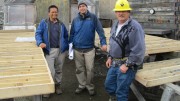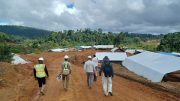Last October’s miraculous rescue of 33 trapped miners at San Jose has catapulted Chile’s Mines Minister Laurence Golborne to the forefront of national politics, even to the point that some are talking of him as a possible presidential candidate in 2013. But he will have to pass some difficult hurdles before then.
At first, there was little sign of what was to come with Golborne. One of a bunch of talented, politically independent newcomers brought into ministerial roles by Sebastian Piñera, Chile’s first rightwing president in 20 years, Golborne was not expected to light fireworks in charge of the country’s mining industry.
Despite the importance of mining to the Chilean economy, the portfolio is normally a low-profile, technical role, managing relations between the government and some powerful foreign investors.
After a few months in power, Golborne was best-known for a handful of clangers: taking a week off to enjoy the World Cup in South Africa, and audibly laughing during a senator’s reply in a press conference. Some feared the former retail executive, with a preference for sharp suits and patterned shirts, might not survive the government’s first cabinet reshuffle whenever it came.
That all changed on Aug. 5, 2010. Hearing of a terrible accident at a small copper and gold mine outside of Copiapo, in the heart of northern Chile’s mining industry, President Piñera, then visiting Ecuador, immediately sent his mines minister to investigate and take charge of efforts to rescue any survivors.
After a piece of mountain twice the size of the Empire State Building had collapsed on top of them, it was far from clear whether any of the 33 workers unaccounted for were still alive. And if they were, how they could be contacted and rescued from the heart of the mine 700 metres below surface.
Golborne was soon the nerve centre of a massive government-led operation, managing relations with the miners’ families, assessing rival rescue solutions from ambitious engineers, and running a multilingual communications effort to meet global demand for news on the unfolding drama. In Chile, the minister became the public face of the rescue effort, giving nightly updates of progress on national television, his emotions often close to the surface, especially when the outlook was grim.
The minister was not just shown to be an able and dynamic leader in a crisis but also one with a genuine human touch, dealing as easily with foreign rig operators as with desperate relatives who frequently complained not enough was being done to rescue their trapped fathers, sons and brothers. Suspicious at first, they soon warmed to him. Invited to join in a campfire singsong, Golborne grabbed a guitar and led the chorus.
And while public opinion was suspicious of Piñera’s involvement, as he apparently only flew in for the major announcements, Golborne, face burnt and hair dusty, had been there through thick and thin. One wag dubbed him “Lawrence of Atacama,” and it’s an epithet that has stuck.
By the time the rescue finally came on the night of Oct. 12, after more than two months of hard drilling, Golborne, together with the miners and the rescue team, were national heroes. Opinion polls now regularly name the once-unknown minister as Chile’s most popular politician with ratings of more than 80%. And while the government’s standing has flagged since, Golborne continues to attract public adoration. Inaugurating Vale‘s (VALE-N) new Tres Valles operation in the dusty town of Salamanca last December, schoolchildren, mineworkers and local bigwigs mobbed the minister for a photo, an autograph or both.
A second triumph followed hot on the heels of the rescue when Congress approved an increase of Chile’s mine royalty to help fund reconstruction after last year’s massive earthquake. Tax stability contracts meant the law had to include an optional component if the government wanted to raise additional funds before these contracts expire in 2017. Golborne argued hard that mining firms risked harming their public image if they refused to pay up (in exchange for a new tax stability period) when some families were still camped under tarpaulin.
The play worked. In January, he was able to announce that almost all the major mining firms operating in the country had adhered to the scheme, which promises to raise an additional US$2 billion over the next three years.
Many believe that the former retail executive has the popularity and profile to cut it as a presidential candidate, as Chile’s constitution prevents Piñera from running in 2014. As well as the skills and empathy ably displayed at San Jose, commentators point to a back-story to which many Chileans will warm.
Most of the political elite come from privileged backgrounds and a handful of exclusive schools in Santiago’s leafy eastern suburbs. Golborne, meanwhile, hails from a humdrum satellite town, the son of an ironmonger with English ancestry. His break came with a place at Santiago’s highly selective National Institute, a rare oasis of excellence in the country’s mediocre public education system and already the alma mater to several presidents.
After dazzling in his business administration course at the prestigious Catholic University, Golborne rapidly scaled the corporate ladder, ending up as CEO of retail group Cencosud, which operates malls, supermarkets and department stores throughout the region. While the firm’s German-born founder Horst Paulman provided the vision, Golborne was the financial brains behind its expansion into new countries and markets.
The company’s success, solidly based on the growing prosperity of South America’s rising middle class, is now etched into the Santiago skyline. Cencosud’s Costanera Centre, a complex combining shopping, offices, and hotels, promises to be the continent’s tallest building once finished.
Thanks to shares bought at Cencosud’s public listing in 2004, the minister is now worth several million dollars. His climb from middle-class obscurity to the centre of wealth and power is one that many admire in Chile’s highly unequal society.
Now at the forefront of national politics, the minister has been courted by party bosses keen to know his plans and ambitions, and hoping that some of his magic might rub off on them.
Others are less enamoured. Piñera’s loyal lieutenant Interior Minister Rodrigo Hinzpeter, a presidential hopeful himself, suggested the newcomer ought to earn his political spurs first.
So far Golborne has teased his followers, keeping his cards close to his chest and saying that 2013 is still too far away to consider. And anyways, he and Chileans have other challenges to contend with before then.
In a cabinet reshuffle in early January, Piñera named Golborne his new Minister for Energy while retaining responsibility for Mines. The two portfolios are a good fit, as both sectors require massive investment over the coming years and mining is one of the country’s largest power consumers.
The move will give a higher profile for the government’s popular minister but also bring his evident skills to bear on one of the country’s thorniest problems: how to keep the lights on as energy demand doubles over the next decade.
The firefighting began immediately. His predecessor, retiring academic Ricardo Raineri, had been brought down after Chile’s southernmost region of Magallanes erupted in massive protests against government plans to slash natural gas subsidies. Higher gas tariffs are needed to encourage drilling to bolster waning reserves and to support indebted state energy firm ENAP. Fresh from his swearing-in ceremony, Golborne quickly reached a deal with the protesters, putting off any rise until later this year.
In the eyes of his admirers, the move confirmed Golborne’s Midas touch, though other crises may be less simple to resolve.
The minister is facing one of Chile’s increasingly regular energy crises. Three dry winters have left water leve
ls at the country’s main hydroelectric reservoirs at record low levels. To ward off brownouts, the minister has ordered grid voltage to be cut and urged industry and households to limit consumption. He is confident that rationing will not be necessary but tariffs are likely to rise as costly oil-fired generators are turned on to cover the deficit.
Further ahead, Golborne will have to find longer term solutions to Chile’s energy problems. Firms, including Swiss-based miner Xstrata (XTA-L, XSRAY-O), want to invest billions of dollars developing hydroelectric dams in remote Chilean Patagonia; environmentalists are determined to stop them. Even if the industrialists win approval for the plants, they will need to find a way to transport the electricity to the main consumption centres in central Chile.
The power lines, more than 2,000 km long, would have to cross thousands of properties, including national parks and indigenous lands, which promises a multiplicity of potential conflicts. Environmentalists are equally opposed to a fleet of new coal-fired plants which will provide the bulk of Chile’s new power supplies between now and 2020. Meanwhile, business groups are pushing for nuclear energy, something to which the bulk of the population is opposed. The current government has said it will not take a decision but will have to prepare the ground for a future administration.
Finally, as energy minister, Golborne will have to chair the board at ENAP, the country’s troubled energy business. The company has helped Chile through previous power crises, massively increasing diesel imports and leading construction of the Southern Hemisphere’s first liquid natural gas terminal, but these efforts have left the company heavily indebted and unfocused. The government’s solution is an injection of private capital, but this will face opposition from unions.
It is going to be a busy three years. This could be another chance for Piñera’s golden boy to prove his mettle. Or, political rivals must be hoping, a poisoned chalice. Another miracle may be required.
– Based in Santiago, the author is a freelance journalist specializing in mining. He can be reached at tomazzopardi@vtr.net.






Be the first to comment on "The way from San Jose"